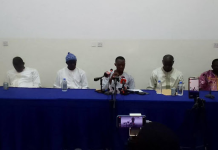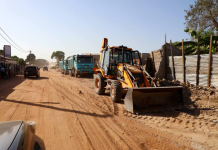By Rohey Jadama
A one day training on the Convention on the Rights of the Child and Ethical  Reporting for the media practitioners was held on Wednesday, 10th September, 2014 at the Girls’ Guide Hall along MDI road in Kanifing.
The workshop was organized through the Media Support to Advocacy, a component under the Gambia Government-UNICEF funded country programme 2012-2016 and being implemented by the Department of Information Services.
Speaking at the ceremony, the UNICEF Communication Specialist, Sally Sadie Singhateh, said the main objective of the training on the UN Convention on the Rights of the Child and Ethical Reporting of Children is to ensure that rights and integrity of all children continue to be protected when they are talked about in the media.
“As the Gambia commemorates the 25th anniversary of the CRC this year, the Government, UNICEF and other significant stakeholders in child rights reinforce our efforts to popularize the achievements that have been made in child rights over the years as well as reduce the gaps by addressing some of the challenges of ensuring that every child enjoys his or her rights,” said Madam Singhateh.
She urged the media to complement their endeavors by making sure that the general public, both nationally and internationally, is aware of the work and gains being made in the Gambia, especially in reaching the children who have been left behind in development.
“In protecting the children, the Gambia domesticated the CRC into the Children’s Act in 2005, which safeguards the rights of children in every aspect of their lives and development. However, there are still cases of abuse, exploitation, neglect and other forms of violent act imposed on children,” revealed the UNICEF Communication Specialist.
She said many children who are still affected are usually very poor, have disabilities or diseases, are stigmatized, abused and exploited, or are in contact or conflict with the law, among other examples. “By working with partners, you can place the public spotlight on their situation, through human interest stories for example, while ensuring that those who are particularly at risk are not exposed to further risk through your stories,” said Madam Singhateh.
In his opening statement, Mr. Lamin Camara, the Permanent Secretary Ministry of Information and Communication Infrastructure, said the programme aims to actively involve journalists in national advocacy efforts in order to create visibility through the media on the situation of women and children in the Gambia. He said additionally, the media support to advocacy component seeks to strengthen the capacity of media practitioners to effectively disseminate progress, achievements and gaps relating to child rights, child protection and the equity agenda.
“A number of donor organizations have over the years provided variety of support to the media with particular focus to the local press. Despite this effort, the capacity and general effectiveness of the media to report on child right issues and in particular, showcasing the different disparities faced by children in accessing the very basic social service, still remains inadequate,” said the MOICI PS.
Mr. Camara said the media can serve as a powerful tool in supporting advocacy efforts for children and women by creating a strong programme visibility, focusing on the achievements and remaining gaps. These evidence based findings, he added, could be used by media in their advocacy efforts to develop key messages targeting policy and decision makers, community leaders on issues negatively affecting the vulnerable segments of the population.
]]>
Reporting for the media practitioners was held on Wednesday, 10th September, 2014 at the Girls’ Guide Hall along MDI road in Kanifing.
The workshop was organized through the Media Support to Advocacy, a component under the Gambia Government-UNICEF funded country programme 2012-2016 and being implemented by the Department of Information Services.
Speaking at the ceremony, the UNICEF Communication Specialist, Sally Sadie Singhateh, said the main objective of the training on the UN Convention on the Rights of the Child and Ethical Reporting of Children is to ensure that rights and integrity of all children continue to be protected when they are talked about in the media.
“As the Gambia commemorates the 25th anniversary of the CRC this year, the Government, UNICEF and other significant stakeholders in child rights reinforce our efforts to popularize the achievements that have been made in child rights over the years as well as reduce the gaps by addressing some of the challenges of ensuring that every child enjoys his or her rights,” said Madam Singhateh.
She urged the media to complement their endeavors by making sure that the general public, both nationally and internationally, is aware of the work and gains being made in the Gambia, especially in reaching the children who have been left behind in development.
“In protecting the children, the Gambia domesticated the CRC into the Children’s Act in 2005, which safeguards the rights of children in every aspect of their lives and development. However, there are still cases of abuse, exploitation, neglect and other forms of violent act imposed on children,” revealed the UNICEF Communication Specialist.
She said many children who are still affected are usually very poor, have disabilities or diseases, are stigmatized, abused and exploited, or are in contact or conflict with the law, among other examples. “By working with partners, you can place the public spotlight on their situation, through human interest stories for example, while ensuring that those who are particularly at risk are not exposed to further risk through your stories,” said Madam Singhateh.
In his opening statement, Mr. Lamin Camara, the Permanent Secretary Ministry of Information and Communication Infrastructure, said the programme aims to actively involve journalists in national advocacy efforts in order to create visibility through the media on the situation of women and children in the Gambia. He said additionally, the media support to advocacy component seeks to strengthen the capacity of media practitioners to effectively disseminate progress, achievements and gaps relating to child rights, child protection and the equity agenda.
“A number of donor organizations have over the years provided variety of support to the media with particular focus to the local press. Despite this effort, the capacity and general effectiveness of the media to report on child right issues and in particular, showcasing the different disparities faced by children in accessing the very basic social service, still remains inadequate,” said the MOICI PS.
Mr. Camara said the media can serve as a powerful tool in supporting advocacy efforts for children and women by creating a strong programme visibility, focusing on the achievements and remaining gaps. These evidence based findings, he added, could be used by media in their advocacy efforts to develop key messages targeting policy and decision makers, community leaders on issues negatively affecting the vulnerable segments of the population.
]]>



















